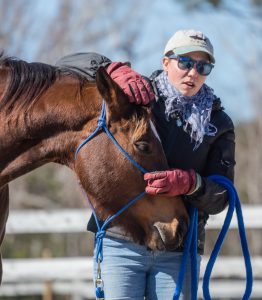Editor’s Note: Amy Skinner is a regular guest columnist and has been a horse gal since age six. She has presented twice at the Best Horse Practices Summit and is the author of To Catch a Horse: Finding the Heart of your Horsemanship.
She rides and teaches dressage and Western. Skinner has studied at the Royal Andalusian School of Equestrian Art in Spain, with Brent Graef, Leslie Desmond, and many others. Visit her website here.
This article follows her popular piece 6 Signs: Toxic Trainer Test.

Amy Skinner at the BHPS 2018
Amy writes:
So you’ve left a toxic trainer. Rebuilding confidence and starting with a new teacher can be daunting. Here are five suggestions for regaining confidence with this new teacher:
1 – Ignore the fame or lack thereof surrounding a new teacher. It’s easy to get swept up in the glowing reports from others just as it’s easy to dismiss another trainer because they are out of the limelight. Learn to see someone’s ability for what it is, not the opinions of some, which can be amplified or diminished disproportionately.
2- Watch teachers before selecting one. Watch their lessons. Watch their work with horses. Hang around for long enough to get a feel for how they behave with all kinds of students and horses. I never mind when people audit before riding with me. It’s a smart thing to do.
Do they have overall respect for horses and people?
Are they putting on a good face?
Are they irritable or proud?
3- Know your needs. Sit down and write out what you hope to gain from your new teacher or your new path. If you had a wreck, you might want your new teacher to understand your fears and concerns. If you are easily triggered by yelling, it’s important to make that clear. The more you know what will upset you, scare you, or bother you, the more you can help your new teacher help you.
Once you’ve lost confidence, it’s easy for a new teacher to push the wrong button accidentally, even with good intentions. If you can make your needs clear, they can help you more successfully.

Amy Skinner works with a young horse
4- Practice advocating for yourself and for your horse. And get good at it. I have students who have had bad experiences with trainers; they can be too harsh with their horses and don’t let teachers handle their horse in a lesson. As a teacher and a student, I get it. I am not offended. I’ll do my best to explain that I might help them more effectively in this way.
If you feel like it’s not the right time to canter, say so.
If you feel like your horse needs a break, say so.
But bear in mind that having your new teacher push you a little might just be exactly what you need. Keep an open mind, especially if your new teacher has shown to be working in your and your horse’s best interest.
5- Give it time. It might be a while before you feel relaxed enough to learn. It can take time to build a new, trusting relationships. Try not to rush. Let things evolve naturally. As the teacher gets to know you better, they will be able to read your needs better and help you more.
Leaving a toxic trainer can be demoralizing, frustrating and scary. You might feel like you don’t know where to turn or how exactly to proceed. You might feel like you don’t even know how to ride anymore. But by taking the time to do research on new instruction, giving it time, and learning to communicate and stick up for yourself, you can blossom to the best of your ability. Sometimes, with that first uncomfortable leap, a hardship can spin into a great opportunity.